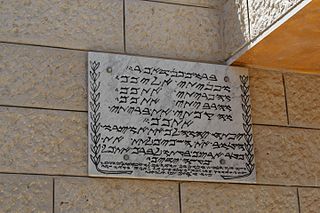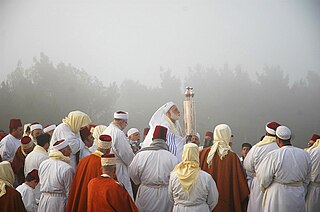
Samaritanism is an Abrahamic, monotheistic, and ethnic religion. It comprises the collective spiritual, cultural, and legal traditions of the Samaritan people, who originate from the Hebrews and Israelites and began to emerge as a relatively distinct group after the Kingdom of Israel was conquered by the Neo-Assyrian Empire during the Iron Age. Central to the faith is the Samaritan Pentateuch, which Samaritans believe is the original and unchanged version of the Torah.

The Septuagint, sometimes referred to as the Greek Old Testament or The Translation of the Seventy, and often abbreviated as LXX, is the earliest extant Greek translation of the Hebrew Bible from the original Hebrew. The full Greek title derives from the story recorded in the Letter of Aristeas to Philocrates that "the laws of the Jews" were translated into the Greek language at the request of Ptolemy II Philadelphus by seventy-two Hebrew translators—six from each of the Twelve Tribes of Israel.

The Samaritans, or the Samaritan people, are an ethnoreligious group originating from the Hebrews and Israelites of the ancient Near East. They are indigenous to Samaria, a historical region of ancient Israel and Judah that comprises the northern half of today's West Bank. They are naturally adherents of Samaritanism, an Abrahamic, monotheistic, and ethnic religion that developed alongside Judaism.

The Samaritan Pentateuch, also called the Samaritan Torah, is the sacred scripture of the Samaritans. Written in the Samaritan script, it dates back to one of the ancient versions of the Torah that existed during the Second Temple period, and constitutes the entire biblical canon in Samaritanism.

Moriah is the name given to a mountainous region in the Book of Genesis, where the binding of Isaac by Abraham is said to have taken place. Jews identify the region mentioned in Genesis and the specific mountain in which the near-sacrifice is said to have occurred with "Mount Moriah", mentioned in the Book of Chronicles as the place where Solomon's Temple is said to have been built, and both these locations are also identified with the current Temple Mount in Jerusalem. The Samaritan Torah, on the other hand, transliterates the place mentioned for the binding of Isaac as Moreh, a name for the region near modern-day Nablus. It is believed by the Samaritans that the near-sacrifice actually took place on Mount Gerizim, near Nablus in the West Bank.

Sefer haYashar is a medieval Hebrew midrash, also known as the Toledot Adam and Divrei haYamim heArukh. The Hebrew title "Sefer haYashar" might be translated as the "Book of the Correct Record", but it is known in English translation mostly as The Book of Jasher following English tradition. Its author is unknown.
Sefer Yetzirah is the title of a book on Jewish mysticism, although some early commentators, such as the Kuzari, treated it as a treatise on mathematical and linguistic theory as opposed to Kabbalah. The word Yetzirah is more literally translated as "Formation"; the word Briah is used for "Creation". The book is traditionally ascribed to the patriarch Abraham, although others attribute its writing to Rabbi Akiva. Modern scholars have not reached consensus on the question of its origins. According to Rabbi Saadia Gaon, the objective of the book's author was to convey in writing how the things of our universe came into existence. Conversely, Judah Halevi asserts that the main objective of the book, with its various examples, is to give to man the means by which he is able to understand the unity and omnipotence of God, which appear multiform on one side and, yet, are uniform.

Shechem, also spelled Sichem was an ancient city in the southern Levant. Mentioned as a Canaanite city in the Amarna Letters, it later appears in the Hebrew Bible as the first capital of the Kingdom of Israel following the split of the United Monarchy. According to Joshua 21:20–21, it was located in the tribal territorial allotment of the tribe of Ephraim. Shechem declined after the fall of the northern Kingdom of Israel. The city later regained its importance as a prominent Samaritan center during the Hellenistic period.

Eli was, according to the Book of Samuel, a priest and a judge of the Israelites in the city of Shiloh, ancient Israel. When Hannah came to Shiloh to pray for a son, Eli initially accused her of drunkenness, but when she protested her innocence, Eli wished her well. Hannah's eventual child, Samuel, was raised by Eli in the tabernacle. When Eli failed to rein in the abusive behavior of his own sons, God promised to punish his family, which resulted in the death of Eli's sons at the Battle of Aphek where the Ark of the Covenant was also captured. When Eli heard the news of the captured Ark, he fell from his seat, broke his neck, and died. Later biblical passages mention the fortunes of several of Eli's descendants.

Mount Gerizim is one of two mountains in the immediate vicinity of the Palestinian city of Nablus and the biblical city of Shechem. It forms the southern side of the valley in which Nablus is situated, the northern side being formed by Mount Ebal. The mountain is one of the highest peaks in the West Bank and rises to 881 m (2,890 ft) above sea level, 70 m (230 ft) lower than Mount Ebal. The mountain is particularly steep on the northern side, is sparsely covered at the top with shrubbery, and lower down there is a spring with a high yield of fresh water. For the Samaritan people, most of whom live around it, Mount Gerizim is considered the holiest place on Earth.
Dositheos was a Samaritan religious leader. He was the founder of a Samaritan sect often assumed to be Gnostic in nature, and is reputed to have known John the Baptist, and been either a teacher or a rival of Simon Magus.
The Chronicles of Jerahmeel is a voluminous work that draws largely on Pseudo-Philo's earlier history of Biblical events and is of special interest because it includes Hebrew and Aramaic versions of certain deuterocanonical books in the Septuagint.

Mount Ebal is one of the two mountains in the immediate vicinity of the city of Nablus in the West Bank, and forms the northern side of the valley in which Nablus is situated, the southern side being formed by Mount Gerizim. The mountain is one of the highest peaks in the West Bank and rises to 935 m (3,068 ft) above sea level, some 60 m (200 ft) higher than Mount Gerizim. Mount Ebal is approximately 17 km2 (6.6 sq mi) in area, and is composed primarily of limestone. The slopes of the mountain contain several large caverns which were probably originally quarries, and at the base towards the north are several tombs.

Josippon is a chronicle of Jewish history from Adam to the age of Titus. It is named after its supposed author, Flavius Josephus, though it was actually composed in the 10th century in Southern Italy. The Ethiopic version of Josippon is recognized as canonical by the Ethiopian Orthodox Tewahedo Church and the Eritrean Orthodox Tewahedo Church.

Moses Gaster was a Romanian, later British scholar, the Hakham of the Spanish and Portuguese Jewish congregation, London, and a Hebrew and Romanian linguist. Moses Gaster was an active Zionist in Romania as well as in England, where in 1899 he helped establish the English Zionist Federation.

al-Badhan is a Palestinian village in the Nablus Governorate in the North central West Bank, located 7.28 kilometres (4.52 mi) northeast of Nablus, and 1.5 kilometres (0.93 mi) to the north of Elon Moreh. According to the Palestinian Central Bureau of Statistics (PCBS), the village had a population of 3,171 inhabitants in 2017.
Ancient Hebrew writings are texts written in Biblical Hebrew using the Paleo-Hebrew alphabet before the destruction of the Second Temple in 70 CE.
The Tolidah or Tulida is a Samaritan chronicle that is considered the oldest Samaritan historical work. Written mainly in Hebrew, with sections in hybrid Samaritan Hebrew and Aramaic, the book provides a concise summary of Samaritan history and the dynasty of kohanim up to the Middle Ages.
The Asaṭīr, also known as the Samaritan Book of the Secrets of Moses, is a collection of Samaritan Biblical legends, parallel to the Jewish Midrash, and which draws heavily upon oral traditions known among Jews in the 2nd and 3rd centuries CE. Moses Gaster places its compilation about the middle or end of the third century BCE, and rendered a translation of the work in 1927 with the Royal Asiatic Society in London. Others have said that its language style resembles more the Arabic language used by the scholar Ab Ḥisda [Isda] of Tyre in his poems of the eleventh century CE, and place its composition in the second-half of the tenth-century. The book's title, Asatir, was thought by Gaster to mean "secrets," from which name, he applied to the book its newer title, "The Secrets of Moses." Even so, such an interpretation has nothing to do with the contents of the book, nor with its subject. A more precise translation of the Arabic title of the work, al-Asāṭīr, would be "legends" or "tales," as in the Koranic expression asāṭīr al-Awwalīn.

Iggeret of Rabbi Sherira Gaon, also known as the Letter of Rav Sherira Gaon, and the Epistle of Rav Sherira Gaon, is a responsum penned in the late 10th century in the Pumbedita Academy by Sherira ben Hanina, the Chief Rabbi and scholar of Babylonian Jewry, to Rabbi Jacob ben Nissim of Kairouan, in which he methodologically details the development of rabbinic literature, bringing down a chronological list of the Sages of Israel from the time of the compilation of the Mishnah, to the subsequent rabbinic works, spanning the period of the Tannaim, Amoraim, Savoraim, and Geonim under the Babylonian Exilarchs, concluding with his own time. Therein, Sherira ben Hanina outlines the development of the Talmud, how it was used, its hermeneutic principles, and how its lessons are to be applied in daily life whenever one rabbinic source contradicts another rabbinic source. It is considered one of the classics in Jewish historiography.













